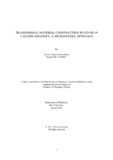Transdermal material construction in covid 19 vaccine delivery: a microneedle approach

View/Open
Date
2021-08Publisher
Brac UniversityAuthor
Chowdhury, Tasnia FarheenMetadata
Show full item recordAbstract
COVID-19 has an impact on people of all ages, races, and ethnicities. Because many infected persons are asymptomatic, the virus is unknowingly transmitted to others, resulting in a rapid spread of illness. Spike protein (S) of coronavirus is a distinctive secondary element of the viral envelope which is regarded as a major target of antibodies designed to detect coronavirus contamination. Microneedle methods, particularly dissolving microneedles, are very helpful and beneficial for achieving herd immunity in the population. There will be increased immunogenicity, less vaccination waste, customized distribution, and so forth. Hollow microneedles and solid microneedles are also viable options for producing the vaccine of COVID-19, and the materials used to make them include ceramic, polymers, carbohydrates, hydrogels, and so on. In order to protect people in this worldwide epidemic, this may be an excellent way of vaccinating against this lethal virus while also ensuring patient compliance.
